The Samsung Galaxy Note 4 Review
by Joshua Ho on October 15, 2014 9:00 AM EST- Posted in
- Smartphones
- Samsung
- Android
- Mobile
- Galaxy Note 4
Battery Life
Battery life is one of the most important aspects of any mobile device, especially because the battery is what defines mobility to begin with. As a result, it’s important to test battery life in a meaningful manner. This requires a repeatable test with standardized conditions, and a range of scenarios that stress different aspects to get the full picture. Most importantly, for tests that have the display on we calibrate the display to 200 nits to ensure that the test doesn’t penalize brighter displays. In the case of the Galaxy Note 4, we see about a 3% gain in battery capacity, so most of the battery life gains should come from higher efficiency.
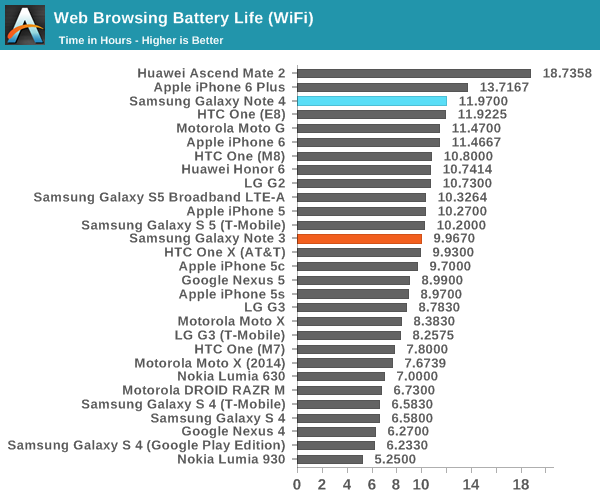
Our first test is the WiFi web browsing test, which loads a given set of web pages in a loop, with special emphasis taken in order to ensure that the test doesn’t penalize faster SoCs, which would have significant effects on our results. As one can see above, the Galaxy Note 4 has a noticeable uplift in battery life when compared to the Galaxy S5 and lasts significantly longer than the Galaxy Note 3. It doesn’t last quite as long as the iPhone 6 Plus, but few people should have issues getting through a full day of intensive use.
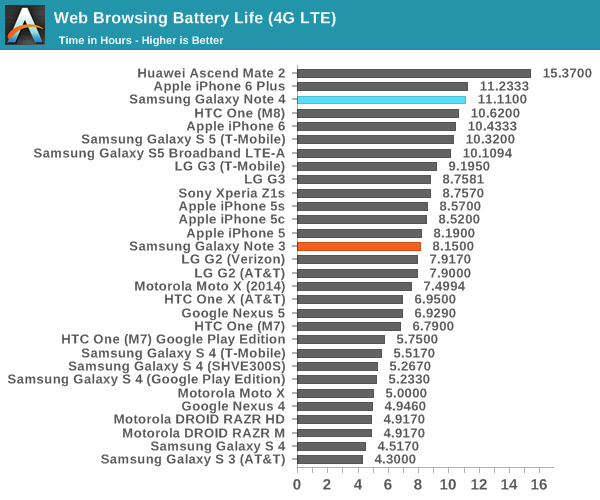
On LTE web browsing, a similar story plays out as the Galaxy Note 4 is able to keep up with the competition and delivers the massive improvement that we’ve generally seen from the transition to Snapdragon 801 and 805.
While the web tests are well-worn by now, we’ve added two additional tests to the battery life suite in order to get a better picture of SoC-bound battery life. To this end, we use an infinite loop of T-Rex on-screen to replicate a GPU-intensive scenario and Basemark OS II’s battery life test to simulate a CPU-intensive scenario.
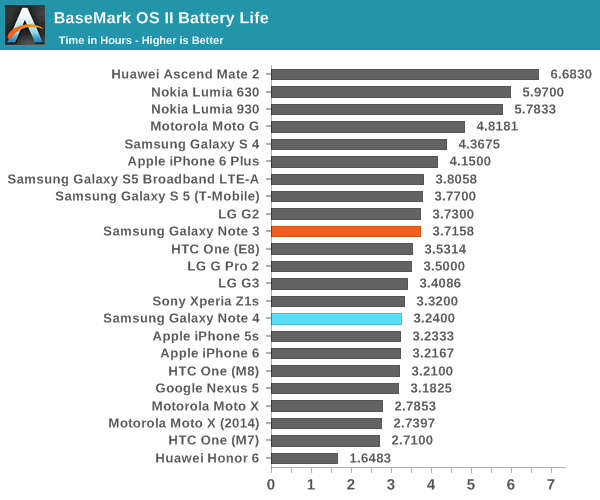
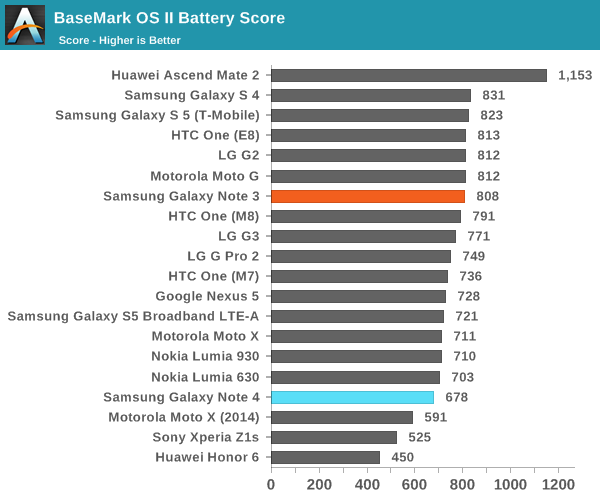
In the case of the Basemark OS II test, we see that battery life under a sustained task ends up a bit lower than we expect, which seems to suggest that in CPU-bound tasks the Note 4 doesn't have much better efficiency when compared to the Galaxy Note 3. This seems to be self-evident, as the CPUs are quite similar and the process technology used is largely similar when comparing the two devices.
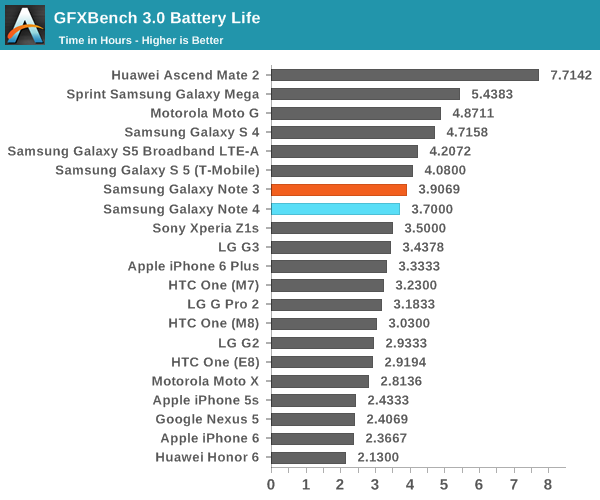
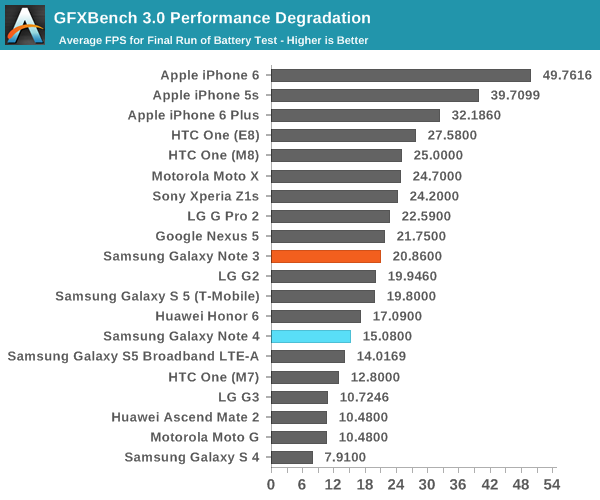
In GFXBench's endless rundown test we see that the Galaxy Note 4 trails behind in battery life when compared to the GS5 LTE-A, but looking at the end of run FPS it’s quite clear that the Galaxy Note 4’s larger surface area makes it possible to achieve greater performance.
Overall, battery life is quite good on the Galaxy Note 4. It’s a massive leap forward when compared to the Galaxy Note 3, but a relatively small one when compared to the Galaxy S5. Once again, we see that most of the benefits in battery life will come from scenarios where power draw isn’t strongly influenced by the display.
Charge Time
As a part of the overall battery life story, it's important to consider the time it takes for a battery to fully charge. If a phone's battery charges slowly then scenarios where charge time becomes crucial will severely hurt real-world battery life. For example, if one forgets to charge their phone at night, the rate at which the phone will charge the battery is a strong influence upon actual battery life. In order to test this, we measure power draw from the time that the device under test is plugged in until it reaches a given level of power draw that indicates that the battery is fully charged.
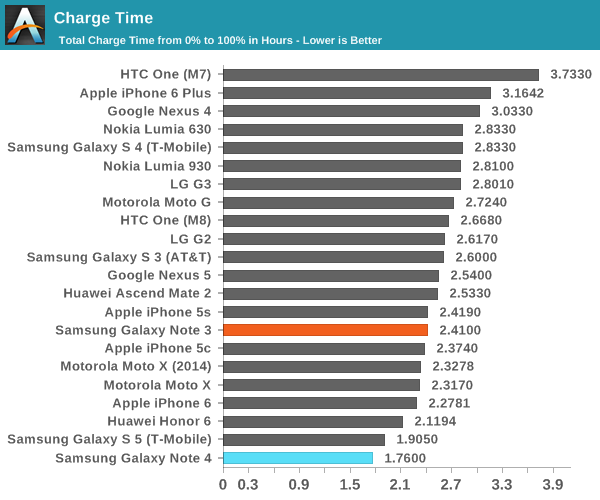
As one can see in the graph above, the adaptive fast-charge mechanism really works, although I don't see a huge benefit when compared to the Galaxy S5's charge time which was already incredibly fast. In the case of the Galaxy Note 4 it seems that it switches between a 9V, 1.64A mode and a 5V, 2A mode as needed, and most of the benefit would come from the first 50% or so of charging as power drops rapidly as the battery approaches full charge.










195 Comments
View All Comments
MattL - Thursday, October 16, 2014 - link
Not strange at all, often certain places will get early review devices, they got an early iPhone 6 and 6+ too.Arcetnathon7 - Thursday, October 16, 2014 - link
Yes, but every early review of iPhone 6 and 6+ are "strangely" without any benchmarks.We always have to wait for Anandtech :)
MattL - Friday, October 17, 2014 - link
Well Display Mate had Note 4 and iPhone 6 Plus screen reviews up for a while now... I honestly would trust them more on the screen side of things anyways (they are far more comprehensive in their analysis and are obviously specialized experts in screens)... just curious as to the differences seen between theirs and the analysis here since they found the Note 4 definitely more accurate vs here.I do agree that you see very few iPhone 6 reviews with benchmarks though.
I would be very interested in other sites doing in-depth screen analysis runs, should give a better picture... but unfortunately not many sites do and the couple others I have seen are *horrible*, they didn't even realize that the Note 4's screen modes actually supported different color gamuts so they critiqued the color accuracy on the Adaptive mode specifically designed to have a high saturation of the color gamut to fend off ambient light washing out that saturation or the Photo mode which supports the Adobe RGB color gamut (17% larger than sRGB) do a high degree of accuracy, but when viewing non Adobe RGB content it will analyze off obviously. While the Basic mode is designed to be extremely color accurate to the sRGB standard (again Display Mate found it to be the most accurate of any smartphone or tablet screen, even the iPhone 6 screens)... so those sites results are pointless.
tralalalalalala40 - Saturday, October 18, 2014 - link
Does the user have to manually change the color scheme on the note4 for every app?tralalalalalala40 - Saturday, October 18, 2014 - link
The golden phone review, hand picked by robots maybe? At least they aren't programming their phones to cheat benchmarks anymore (most likely)trynberg - Wednesday, October 15, 2014 - link
So, the iPhone 6+ is declared the best phablet with no supporting statements or qualifications. The Note 4 gets "remains one of the best phablets on the market, but whether it's the best for a given user is a matter of priorities and personal preference rather than any absolutes".I mean, how blind do you have to be to not see the bias there?
KPOM - Wednesday, October 15, 2014 - link
This is actually a much more positive review of the Note 4 than ArsTechnica. AT basically said it comes down to your OS preference.MattL - Thursday, October 16, 2014 - link
Ars had the most negative Note 4 review I've seen anywhere on the web... really surprised about that, very disappointed.tralalalalalala40 - Saturday, October 18, 2014 - link
Go to samsung's website, they have a great review of the note 4 that should cheer you up.TrackSmart - Wednesday, October 15, 2014 - link
Thanks for the review! As always, this is much more complete information than you find at competing sites.That said, the Battery Charging Speed Test is not as useful as it could be. Supposedly this phone charges to 50% in the first 30 minutes. That means most of your testing time represents "topping off" the battery. Consider adding 50% or 75% charge speeds instead of (or in addition to) 100%. It would tell us which phones allow a user to quickly get back to business.